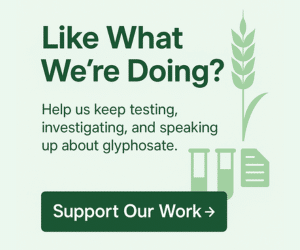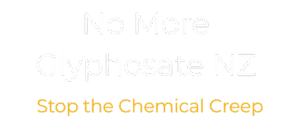When the Parliamentary Commissioner for the Environment released their main report in 2022, that wasn’t the whole story.
This article is part of a 3-article mini-series exploring how New Zealand failed to act on the PCE’s chemical oversight recommendations.
- Part 1: The PCE’s Warning We Ignored
- Part 2: What the Consultants Found About Monitoring Gaps (you are here)
- Part 3: The Reforms That Never Landed
Sitting underneath that headline document were consultant papers that did the unglamorous work — the digging, the data mapping, and the reality-checking. These were the reports that looked at how chemical monitoring actually works across the regions of New Zealand.
And what they found explains a lot.
Because, while we talk a lot about glyphosate, the bigger issue is that our monitoring system wasn’t built to properly track the fate of any high-use chemical — not in a consistent, nationwide way. Different councils monitor different contaminants. Some substances are routinely checked in one region, yet not at all in the next. There is no universal baseline, and no shared standard for tracking what’s in soil, waterways, or sediment over time.
The consultants were essentially asking:
- who measures what?
- where is it measured?
- and how comparable is that data between regions?
And once you see that picture clearly — you start to understand why glyphosate residue data is so fragmented, why national clarity is so hard to get, and why independent testing has become a necessary part of the conversation.
Because when the groundwork is patchy… the conclusions will be too.
What These Consultant Papers Were Actually Looking At
The consultants weren’t reviewing the chemicals themselves — they were reviewing the systems we rely on to keep track of them. Their job was to map out what councils are measuring across New Zealand, and how consistently (or inconsistently) that monitoring happens.
In other words, if the main PCE report was the “why this matters”, the consultant papers were the “what’s really happening out there”.
They found a patchwork.
Some regions routinely check for certain contaminants in rivers or sediments. Others focus more on groundwater. Some test urban catchments more often than rural areas. And even the methods used — how samples are taken, how often, and how results are reported — vary from place to place.
So instead of one coherent national picture, we end up with dozens of different fragments.
And that has consequences.
Because it means that whether a chemical is visible in the data can depend on where it’s used, or who happens to be measuring in that particular region, it also means that two councils might both be monitoring for “chemical contaminants” — but not necessarily the same ones.
That finding alone should make us sit up.
If our baseline information isn’t aligned, then how can national risk be accurately understood — or compared — at all?
Why This Patchwork Approach Creates Blind Spots
When monitoring is inconsistent, it becomes very easy for high-use chemicals to slip under the radar. Even if a contaminant is common nationwide, it may only be routinely measured in a handful of regions — or not at all. So the absence of evidence doesn’t necessarily mean “safe”. It can simply mean “not measured here”.
And this is where glyphosate-based herbicides such as Roundup become a useful example.
We know it is one of the most widely used herbicides in New Zealand. We know it’s applied in agriculture, on roadsides, around orchards, and in public spaces. We know it turns up in food residues — because we’ve seen it in MPI’s own past surveys, and in independent tests both here and overseas.
But if monitoring varies region by region, and there is no nationwide standard for measuring herbicides in soil or water, then a chemical like glyphosate can be almost invisible in official datasets.
Not because it isn’t present.
But because we aren’t consistently looking for it.
That is what these consultant papers revealed — not a scandalous smoking gun, but something almost more concerning: a system that simply doesn’t have the structure required to see the full picture.
How This Links Back to the Bigger Picture
When you step back, the consultant findings make something very clear: we don’t just have data gaps — we have structural blind spots. If different regions measure different contaminants, using different methods, at different frequencies, then the national picture becomes a patchwork of partial truths rather than a reliable evidence base.
And these gaps aren’t just theoretical. They affect what we think we know about chemicals that are used every day — including glyphosate-based herbicides such as Roundup. If the fate of these products isn’t tracked in a consistent way across the country, then any claims about how much ends up in soil, sediment, or waterways are based on assumption rather than comprehensive evidence.
This is how a high-use chemical can appear “low risk” — simply because there’s limited monitoring in the very places it’s most likely to show up.
So when people argue that glyphosate doesn’t accumulate, or doesn’t persist, or doesn’t show up in our environment in concerning ways, the truth is more uncomfortable:
we don’t actually have the national data to confirm or deny those claims.
And that is exactly what the consultants were flagging.
The weakness isn’t only in how we interpret the monitoring — it’s in how we collect it in the first place.
Why This Matters for Public Trust
Most New Zealanders reasonably assume that if a chemical is widely used — especially something as common as glyphosate-based herbicides — then someone, somewhere, is tracking where it goes and what it’s doing. It’s a normal expectation. We expect oversight. We expect follow-through. And we expect monitoring to be part of the deal.
But what these consultant reports revealed is that the system wasn’t designed that way. It wasn’t built to deliver a unified national view of chemical presence in soil, waterways, or sediment. Instead, it reflects historical priorities, different resourcing levels, regional preferences, and legacy decision-making.
So when people say things like “if it was a problem, the authorities would know,” this is the uncomfortable reality behind that assumption: they might not know because they might not be looking in the right place — or in some regions, looking at all.
Public confidence in environmental safety relies on the belief that monitoring is real, robust, and comparable.
If the foundation of that belief is uneven, then the trust built on top of it is uneven too.
The Bigger Question Behind All of This
It’s easy for reports like these to be seen as technical or dry, because they talk in terms of systems, frameworks, and monitoring pathways. But underneath all that language sits a very human reality: the food we eat, the water we drink, the soil we grow in. Chemical fate isn’t an academic exercise — it’s the difference between understanding exposure or guessing at it.
And once you realise how fragmented the underlying data really is, it becomes harder to take reassurance at face value. Because reassurance without evidence is just messaging.
This isn’t about being alarmist. It’s about being honest.
The consultant reports stripped away the assumption that “someone else has this covered”. They showed that the monitoring system wasn’t designed to detect emerging patterns — especially for high-use herbicides such as Roundup that move through our landscapes every day.
Which leads to the bigger question: how can we have confidence in safety claims, when the foundational data isn’t aligned enough to support them?
What This Really Signals About Environmental Oversight in New Zealand
It signals that our chemical monitoring system isn’t failing because of one bad decision — it’s failing because it was never designed to give us a clear national picture in the first place. And when a system isn’t built for clarity, it will naturally default to uncertainty.
That’s what these consultant papers exposed more than anything.
They didn’t reveal a single scandal.
They revealed a structural weakness.
They showed us that blind spots are built into the way monitoring is done.
And this is the part that stings: taxpayers actually paid for this insight. Good money was spent to map out the weaknesses in our monitoring system — and yet the very gaps identified are still sitting there. It raises a fair question: what was the point of commissioning this work if the findings were never going to be acted on?
And that should matter to all of us — because exposure isn’t theoretical. Chemicals don’t stay inside the paperwork. They move through landscapes, waterways, and food chains. Glyphosate-based herbicides such as Roundup are used widely across the country — yet if the monitoring system varies region by region, then our understanding of environmental fate will always be patchy.
Until we align the monitoring, we will continue to rely on assumption instead of evidence.
And that’s how risk becomes normalised — not because it’s been measured, but because it hasn’t.
Resources & References
Below are the primary reports and relevant reads referenced in this article. They form the evidence base behind our claims — and are well worth exploring if you’d like to dig deeper.
PCE Report – Regulating the environmental fate of chemicals (2022)
A comprehensive review by the Parliamentary Commissioner for the Environment that examines how chemicals move through land, air and water, and how well (or poorly) New Zealand monitors that movement.
https://pce.parliament.nz/publications/regulating-the-environmental-fate-of-chemicals/
PCE Media Release – Regulating the environmental fate of chemicals
The official press release summarising the findings of the PCE report, giving context and reaction from the Commissioner’s office.
https://pce.parliament.nz/media/pl3imdy3/media-release-regulating-the-environmental-fate-of-chemicals.pdf
Consultant Report – Jacobs NZ Ltd: Chemical contaminants in Aotearoa (2021)
The consultant-level analysis commissioned by the PCE that maps regional monitoring practices, identifies who monitors what, where and how often — and highlights major gaps.
https://pce.parliament.nz/media/4tzdtzeh/jacobs-chemical-contaminants-in-aotearoa.pdf
PCE FAQ Document – Regulating the environmental fate of chemicals
A shorter, more accessible FAQ version of the PCE’s main report that breaks down key questions and findings in a reader-friendly format.
https://pce.parliament.nz/media/srgf5d5k/faqs-regulating-the-environmental-fate-of-chemicals.pdf
PCE Submission: Hazardous Substances & New Organisms (HSNO) – Assessment Amendment Bill
The PCE’s formal submission on proposed regulatory reforms in New Zealand, showing how the regulatory system is being asked to respond (or not) to monitoring gaps.
https://pce.parliament.nz/media/rdrbu0su/submission-on-hazardous-substances-assessments-amendment-bill-pdf-240kb.pdf
PCE Letter to Ministers – Pollutant Release & Transfer Register (PRTR)
A 2019 letter from the PCE urging the Government to establish a national pollutant release and transfer register — one of the key missing building-blocks the reports cite.
https://pce.parliament.nz/media/0r1khxum/pce-letter-to-ministers-concerning-prtr.pdf
Book Review – Toxic Legacy by Stephanie Seneff
A book-review style article on NoMoreGlyphosate.nz that deep-dives into the long-term biological and environmental risks of chemical exposure — a perfect companion piece for understanding why monitoring matters.
https://nomoreglyphosate.nz/toxic-legacy-stephanie-seneff-review/
This list isn’t about overwhelming you — it’s about equipping you. Each link gives you a piece of the puzzle.
Image Source & Attribution
The image featured on this page is from Depositphotos and credited to the photographer Posonsky.




